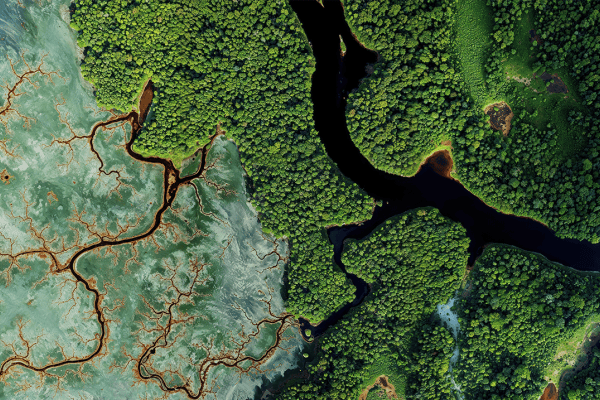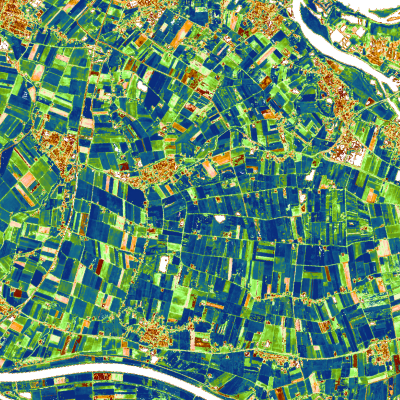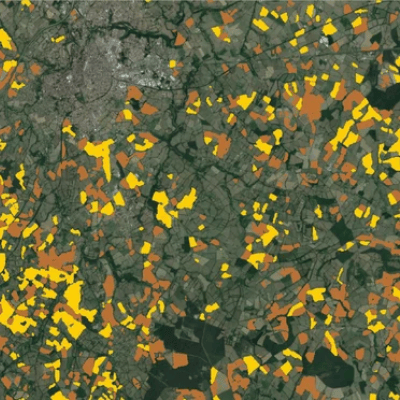Natural Capital Accounting & Biodiversity
Natural Capital Accounting is a standardised statistical framework to measure and value ecosystems.

Mapping the Value of Nature With Earth Observation
Nature and the diversity in biological systems play a crucial role in sustaining economies, societies and human well-being. Yet, its contributions are often overlooked in traditional economic assessments. Natural Capital Accounting (NCA), also known as Ecosystem Accounting, provides a structured framework to quantify the value of ecosystems, ensuring their importance is recognised in decision-making processes. At VITO, we leverage Earth Observation (EO) data, Artificial Intelligence (AI), and geospatial models to advance NCA and biodiversity, supporting sustainable development policies and financial and corporate strategies from local to national level.

What is Natural Capital Accounting?
Natural Capital Accounting (NCA) is a standardised statistical framework (following the SEEA EA standard) that measures and values ecosystems based on their:
- presence (extent),
- condition (quality),
- the services they provide.
These ecosystem services can include:
- Provisioning services: goods that ecosystems provide, such as food, water, and raw materials
- Regulation services: ecosystem functions like climate regulation, pollination, erosion and flood control, water purification
- Cultural services: non-material benefits, including recreation, tourism, and cultural heritage
By integrating spatial and non-spatial data, NCA enables better decision-making for a sustainable future and a nature-positive transformation through providing standard Supply and Use accounting tables, as well as geospatial information in maps.
By mainstreaming ecosystem accounting, VITO supports the Global Biodiversity Framework (GBF), helping countries set national targets and integrate biodiversity values into their policies.
How Can We Monitor and Advance Biodiversity?
Ecosystems are based on biodiversity. Monitoring biodiversity for reversing current biodiversity losses is essential and can be done via measuring Essential Biodiversity Variables (EBVs). EBVs inform among others about ecosystem structure and ecosystem functioning as well as community and species composition. Earth Observation data can contribute to several EBVs by providing high temporal resolution gridded biophysical information on ecosystems and species at large scale. Measurements over time can contribute to change detection, attribution to causes, and guide conservation, restoration, and improvement of biodiversity.
A Geospatial Approach to Ecosystem Accounting and Biodiversity Assessment
Ecosystems function differently depending on their location. At VITO, we integrate Earth Observation geospatial datasets, non-spatial data, and advanced modelling techniques (Artificial Intelligence) to accurately locate and assess ecosystems and track changes over time. With our ecosystem accounts and assessments, we provide:
- Maps that illustrate ecosystem distribution, condition, and service provision
- Geospatial models that quantify nature’s contributions to people in both biophysical and monetary terms
- Monitoring solutions via indicators to assess trends in ecosystem sustainability and human impact and detect their drivers of change
- Predictive modelling tools to assess future ecosystem scenarios and guide sustainable management strategies
- Essential Biodiversity Variables (EBVs) that contribute to standardised biodiversity assessments at regional and global scales
These insights help policymakers, businesses, and conservationists make informed decisions to support biodiversity strategies and sustainable development goals.
Driving the Future of Natural Capital Accounting and Biodiversity Monitoring
At VITO, we are committed to advancing NCA and global biodiversity through cutting-edge research, geospatial analytics, and innovative EO solutions. By integrating Ecosystem Accounting with the latest technological advancements, we empower policymakers, businesses, and conservation organisations to take meaningful action toward a sustainable, nature-positive future.
- Businesses are increasingly required to report on environmental risks and impacts under frameworks such as the Corporate Sustainability Reporting Directive (CSRD). VITO’s NCA tools support businesses by quantifying environmental impacts in consistent physical and financial terms and tracking progress over time in alignment with international biodiversity and ecosystem service targets.
- National decision-makers are to set country goals and targets to safeguard our planet’s biodiversity and ecosystem services by 2050 (such as under the Global Biodiversity Framework (GBF) of the Convention on Biological Diversity (CBD)) and plan, monitor, report and review implementations. VITO’s tools support countries and conservationists to report and monitor in line with standardised methods for incorporating biodiversity values into national accounting and assess human accountability for ecosystem degradation by inappropriate management.

Learn More
Discover more about how VITO is shaping the future of Natural Capital Accounting and biodiversity research.
Related Projects
Ongoing projects:
- Integrated System for Natural Capital Accounting (INCA, 2021-2027): https://ecosystem-accounts.jrc.ec.europa.eu/
- World Ecosystem Extent Dynamics (2024-2026): https://esa-worldecosystems.org/en
- Observation of Ecosystem Changes for Action (2024-2027): https://obsgession.eu/
- Accelerating Transformation Through Capitals Knowledge (2023-2026): https://a-track.info/
- Monitoring of Nature Infrastructure (2025-2027): https://sonata-nbs.com/
- Science for Evidence-Based and Sustainable Decisions about Natural Capital (2021-2026): https://project-selina.eu/
- Evaluation of Natural Capital to Support Land-Use Planning, Improved Management Effectiveness of Terrestrial Protected Areas (2023-2025): UNEP-GEF Project 10389
Finished projects:
- Green Growth Through Natural Capital Accounting in Turkiye (2023-2024): WorldBank Global Program on Sustainability
- Earth Observation in Service of Ecosystem Accounting (2022-2024): https://esa-people-ea.org/en
- Preserving of Biodiversity and Fragile Ecosystems in West-Africa (2019-2022) https://papbio.vito.be/en
Related Blog Articles
- Habitat mapping with AI to preserve Europe's natural capital
- Transition to a sustainable planet through Natural Capital Accounting
- New INCA tool to support ecosystem accounting in Europe
- Flexible habitat mapping for biodiversity and ecosystem management
- Large scale mapping for biodiversity monitoring
Related Scientific Papers
- Bagstad et al. 2025. Interoperability for ecosystem service assessments: Why, how, who and for whom?. Ecosystem Services 72, 101705. https://doi.org/10.1016/j.ecoser.2025.101705
- Buchhorn et al. 2023. Facilitating the Management of Protected Areas through Multi-Level Ecosystem Accounting on an Example in West Africa. Sustainability 15, 9198. https://doi.org/10.3390/su15129198
- Kokkoris et al. 2024. The role of Earth observation in ecosystem accounting: A review of advances, challenges and future directions. Ecosystem Services 70, 101659. https://doi.org/10.1016/j.ecoser.2024.101659
- Buchhorn et al. 2022. Establishing a reference tool for ecosystem accounting in Europe, based on the INCA methodology. One Ecosystem 7, e85389. https://doi.org/10.3897/oneeco.7.e85389
- De Nocker et al. 2023. Valuation of health benefits of green-blue areas for the purpose of ecosystem accounting: a pilot in Flanders, Belgium. One Ecosystem 8, e87713. https://doi.org/10.3897/oneeco.8.e87713
Get in Touch!
Get in touch with us to learn how you can use VITO's Natural Capital Accounting and biodiversity expertise.








